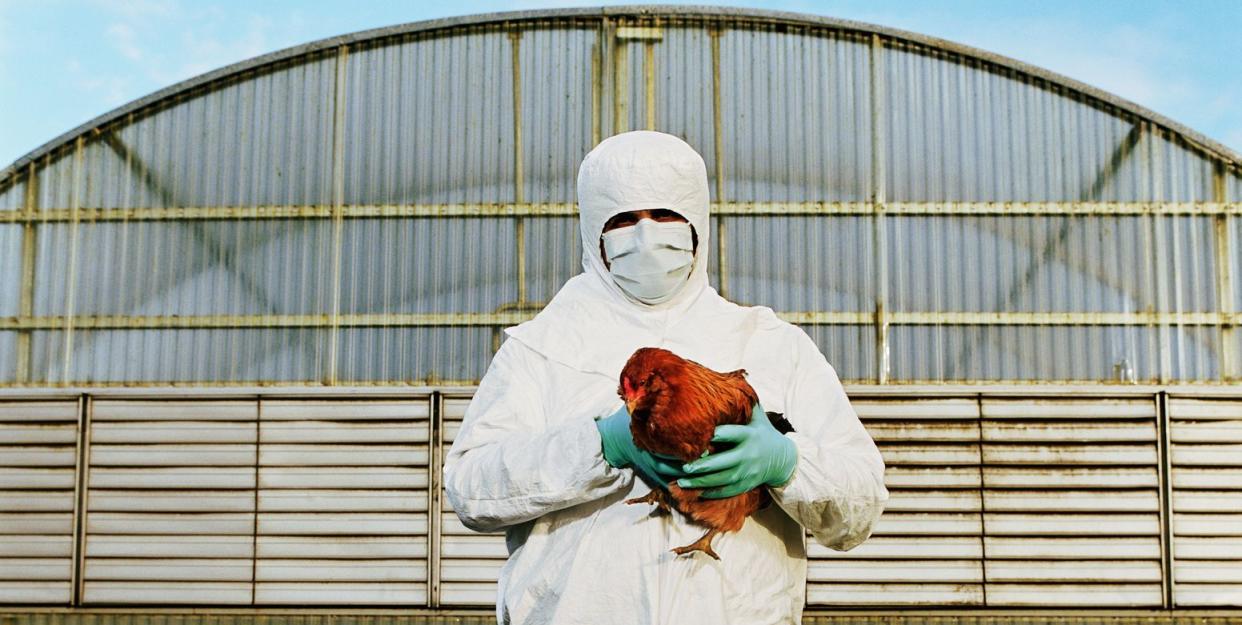Why Public Health Experts Are Monitoring Bird Flu in the U.S.

COVID-19 and the Omicron variant continue to be the main illness people are worried about right now, but government officials are quietly warning about another virus that’s shown up in the U.S.: bird flu.
The United States Department of Agriculture (USDA) recently issued an alert after detecting “highly pathogenic” avian influenza cases in several wild birds. (“Pathogenic,” in case you’re not familiar with the word, means that it can cause disease.) To date, the USDA’s Animal and Plant Health Inspection Service (APHIS) has found a specific strain of bird flu—H5N1 HPAI—in three wild birds through its sampling program. Two were in South Carolina and one was in North Carolina.
“These findings are not unexpected, as wild birds can be infected with HPAI and show no signs of illness,” the USDA said. “They can carry the disease to new areas when migrating. APHIS anticipates additional wild bird findings as our robust wild bird sampling program continues into the spring.”
The USDA is urging people to minimize contact with wild birds and use gloves if you need to interact with them. Hunters and anyone involved in commercial or backyard poultry are encouraged to “practice good biosecurity” to lower the risk of getting sick and spreading the disease.
All of this raises a lot of questions about bird flu and how concerned you should actually be. Infectious disease experts break it down.
What is bird flu, again?
Bird flu, aka avian flu or avian influenza, is a disease caused by infection with avian influenza Type A viruses, according to the Centers for Disease Control and Prevention (CDC). Bird flus happen naturally in wild aquatic birds around the world and can infect poultry, along with other bird and animal species.
While bird flu isn’t common in people, human infections have happened—and this particular strain has a high mortality rate. Data from the World Health Organization (WHO) shows that of the 863 reported H5N1 bird flu cases that happened worldwide between 2003 and 2021, 456 ended in death.
How do people get bird flu?
Infected birds shed avian influenza virus in their saliva, mucus, and poop, the CDC explains, and humans can get infected when that virus gets in a person’s eyes, nose, or mouth, or is inhaled. The virus can get into the air in droplets or dust, and a person can breathe it in, or a person can touch something that has the virus on it and then become infected after touching their mouth, eyes, or nose.
There has been person-to-person spread reported in the past. “Still, it’s pretty rare,” says Thomas Russo, M.D., professor and chief of infectious disease at the University at Buffalo in New York. “At this time, it transmits poorly from humans to humans.”
It’s important to point out that you can’t get bird flu from eating fully cooked poultry products. “You will not get it from eating cooked chicken, ducks, or geese,” says William Schaffner, M.D., an infectious disease specialist and professor at the Vanderbilt University School of Medicine.
However, the CDC does warn against eating raw or undercooked poultry products over bird flu fears. That includes making sure to eat meat and poultry that is fully cooked (not pink) and eating hard-cooked (not runny) eggs.
What are the symptoms of bird flu?
Bird flu can cause a range of potential symptoms in people, from mild to severe, the CDC says. Those include:
Pink eye
Fever
Cough
Sore throat
Muscle aches
Stomach pain
Diarrhea
Vomiting
Shortness of breath
Trouble breathing
Pneumonia
Respiratory failure
Altered mental status
Seizures
Who is at risk of getting bird flu?
Certain people are at a higher-than-usual risk of getting bird flu than others, Dr. Russo says. Those generally include:
Poultry workers
Hunters
Farmers
People with backyard birds and poultry
How is bird flu treated?
If you do happen to catch bird flu, it’s usually treated with antiviral drugs like oseltamivir or zanamivir. People who have had contact with infected birds may also be given antiviral flu medication to try to prevent an infection, the CDC says.
How worried should you be about bird flu?
There are a few reasons why this latest detection of bird flu has people in the infectious disease and agriculture community talking. There are two strains of bird flu that have caused the most human illnesses, serious infections, and deaths worldwide, per the CDC—H7N9 and H5N1, the lineage that has most recently been detected in the U.S.
While bird flu doesn’t spread easily between humans, infectious disease experts are concerned that will change at some point. “Before SARS-CoV-2 [the virus that causes COVID-19], H5N1 and other bird flu strains are what we’ve been concerned about causing a pandemic,” Dr. Russo says. “It’s just yet to happen.”
But the possibility of bird flu spreading rapidly in people is why experts continue to keep a close eye on it. “There’s always the concern that this bird flu strain may infect a person who is already infected with conventional influenza, those two viruses will get together and share their genetics, and then perhaps the bird flu gets the capacity to spread more efficiently from person to person,” Dr. Schaffner says.
Worth noting: The CDC says that it’s “extremely important” to monitor for human infections of bird flu for this reason.
But, all of that said, experts say this isn’t something the average person should stress about at the moment. “Right now, people should not be freaking out about this,” Dr. Russo says. “This is something that has been out there for a while and it hasn’t been able to evolve further. However, continued surveillance is critical and important.”
Dr. Schaffner agrees. "This alert is for all of us in public health," he says. "It's something we'll keep an eye on."
You Might Also Like

